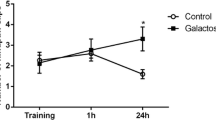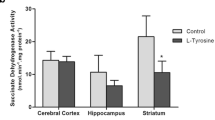Abstract
Short-term experiments in whichl-cycloserine, the inhibitor of 3-ketodihydrosphinogosine synthase, was injected subcutaneously in young mice have shown that cerebroside synthesis is inhibited specifically. Studies on the effect of long terml-cycloserine treatment on sphingolipid synthesis were performed to determine whether mice could tolerate continued cerebroside reduction and whether or not the synthesis of other sphingolipids would be inhibited.l-cycloserine, when injected at a low dose for a period of two months resulted in significantly reduced brain cerebroside level with little or no reduction in sulfatide, ganglioside, or sphingomyelin levels; liver and spleen glucocerebroside levels were also significantly reduced. The rate of cerebroside synthesis in brain was greatly reduced, whereas synthesis of sulfatides was much less affected byl-cycloserine indicating that a portion of newly synthesized galactocerebroside is shunted to synthesis of sulfatides.
Similar content being viewed by others
References
Sundaram, K. S., and Lev, M. 1984. Inhibition of sphingolipid synthesis by cycloserine in vitro and in vivo., J. Neurochem. 42:577–581.
Sundaram, K. S., and Lev, M. 1984. L-cycloserine inhibition of sphingolipid synthesis in the anaerobic bacteriumBacteroides levii Biochem. Biophys. Res. Comm. 119:814–819.
Williams, R. D., Sgoutas, D. S., Zaatari, G. S., and Santoianni, R. A. 1987. Inhibition of serine palmitoyltransferase activity in rabbit aorta byl-cycloserine. J. Lipid Res. 28:1478–1481.
Sundaram, K. S., and Lev, M. 1985. Inhibition of cerebroside synthesis in the brains of mice treated with L-cycloserine. J. Lipid Res. 26:473–477.
Lev, M., and Sundaram, K. S. 1987. Gaucher's disease. N. Engl. J. Med. 317:572.
Folch, J., Lees, M., and Sloane Stanley, G. W. 1957. A simple method for the isolation and purification of total lipids from animal tissues. J. Biol. Chem. 226:497–509.
Svennerholm, L. 1957. Quantitative estimation of sialic acids 11. A colorimetric resorcinol-hydrochloric acid method. Biochim. Biophys. Acta. 24:604–611.
Mietinen, T., and Takki-Luukkainen, I. T. 1959. Use of butyl acetate in determination of sialic acid. Acta. Chem. Scand. 13:856–858.
Young, O. M., and Kanfer, J. N. 1965. An improved separation of sphingolipids by thin layer chromatography. J. Chromatogr. 19:611–613.
Hess, H. H., and Lewin, E. 1965. Microassay of biochemical structural components in nervous tissues. II. Methods for cerebrosides, proteolipid protein and residual proteins. J. Neurochem. 12:205–211.
Misra, U. K. 1968. Thin layer chromatographic estimation of rat plasma and tissue lipids. Biochem. Biol. Speri. VII:1–2, 57.
Bartlett, G. R. 1959. Phosphorous assay in column chromatography. J. Biol. Chem. 234:466–468.
Marinetti, G. V. 1962. Chromatographic separation, identification and analyses of phosphatides. J. Lipid Res. 3:1–20.
Morell, P., and Radin, N. S. 1970. Specificity in ceramide biosynthesis from long chain bases and various fatty acyl coenzyme A's by brain microsomes. J. Biol. Chem. 245:342–350.
Lev, M., and Milford, A. F. 1981. The 3-ketodihydrosphingosine synthetase ofBacteroides melaningenicus, partial purification and properties. Arch. Biochem. Biophys. 212:424–431.
Carter, T. P., and J. N. Kanfer, J. N. 1974. Observations on the biosynthesis of rat brain ceramide and cerebroside in vivo. J. Neurochem. 23:589–594.
Radin, N. S. 1984. Biosynthesis of the sphingoid bases; a provocation. J. Lipid Res. 25:1536–1540.
Sundaram, K. S., and Lev, M. 1988. Warfarin administration reduces synthesis of sulfatides and other sphingolipids in mouse brain. J. Lipid Res. 29:1475–1479.
Hajra, A. K., and Radin, N. S. 1963. Isotopic studies of the biosynthesis of the cerebroside fatty acids in rats. J. Lipid Res. 4:270–278.
Brady, R. O., and Barranger, J. A. 1983. Glucosylceramide lipidosis: Gaucher's disease, Pages 842–856in Stanbury, J. B., Wyngaarden, J. B., Fredrickson, D. S., Goldstein, J. L. and Brown, M. S. (eds.) The Metabolic Basis of Inherited Disease. McGraw-Hill, New York.
Author information
Authors and Affiliations
Rights and permissions
About this article
Cite this article
Sundaram, K.S., Lev, M. The long-term administration ofl-cycloserine to mice: Specific reduction of cerebroside level. Neurochem Res 14, 245–248 (1989). https://doi.org/10.1007/BF00971318
Accepted:
Issue Date:
DOI: https://doi.org/10.1007/BF00971318




